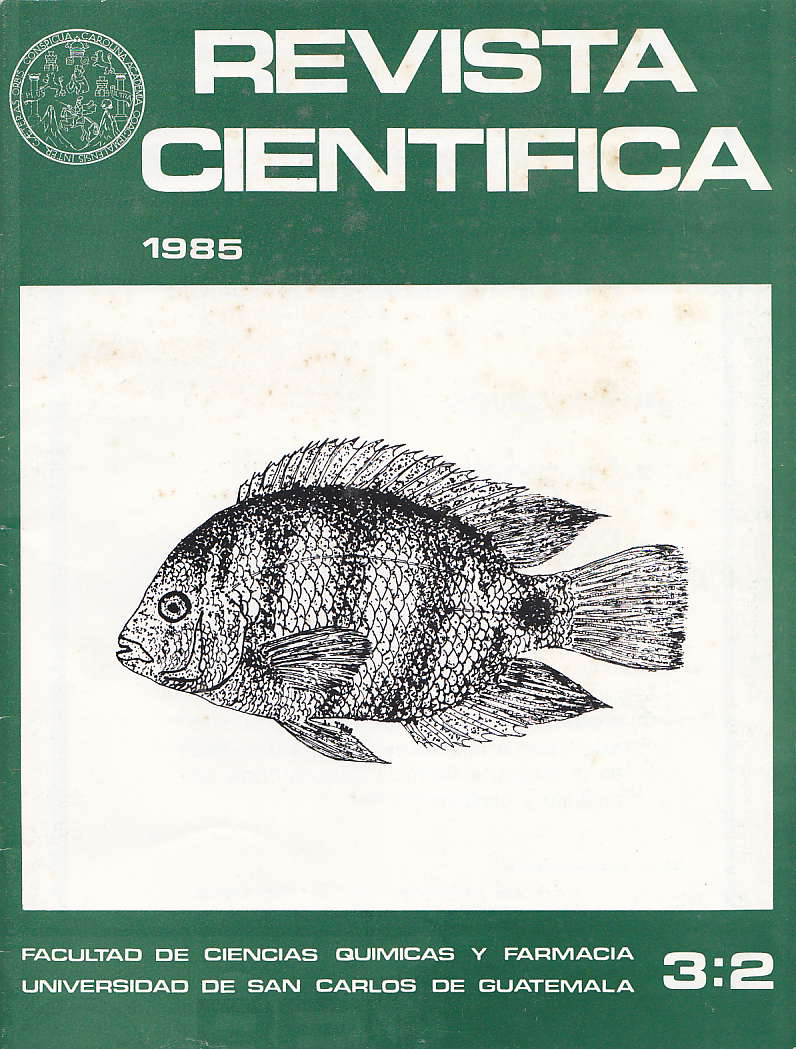Preliminary determination of the feeding habits of three species of cicudos (family Cichlidae, Osteichthyes) from the Creeke Jute River, by means of analysis of stomach contents
DOI:
https://doi.org/10.54495/Rev.Cientifica.v3i2.461Keywords:
preliminary determination, feeding habits , species of cicudos , family Cichlidae, Osteichthyes , Creeke Jute River, analysis, stomach contentsAbstract
The feeding habits of Cichlasoma aureum (Günther), Cichlasoma robertsoni Regan, and Cichlasoma spilurum (Günther) were preliminarily studied in the Creeke Jute River, a small stream on the Atlantic slope of Guatemala, between November 1983 and May 1983. The results obtained from the analysis of the stomach contents of the studied fish were: - C. aureum was found to be a benthic omnivore that generally feeds on benthic invertebrates and detritus. - C. robertsoni is a benthic-nectonic omnivore that generally feeds on benthic invertebrates and detritus. - C. spilurum is a benthic omnivore that generally feeds on benthic or near-benthic algae, some benthic invertebrates, and detritus. The following were established for the three species studied: i) seasonal changes in their feeding habits; ii) the consumption of animal feed, which is mostly benthic in habit, is not directly proportional to the consumption of detritus and vice versa; iii) they are omnivorous fish (euryphagous) for which detritus plays an important role in their diet; iv) to compensate for the lack of plant and/or animal food items, these three species consume detritus as an adaptation to the temporary conditions of the environment for their subsistence; v) finally, that any habitat modification, which results in a reduction in the supply of detritus, will directly affect the populations of all three species, reducing their numbers.
Downloads
References
Bovay Engineers, INC., Urruela & Sittenfeld y Cía. Ltda. Estudio de prefactibilidad para un plan maestro de los recursos naturales renovables de Guatemala. Guatemala: Consejo Nacional de Planificación Económica. Vols. 12, Vol. 6, 1975. XII 90p.
Rosales F. Contribución al conocimiento de algunos aspectos biológicos de Cichlasoma trimaculatum Günther, mojarra roja, y Cichlasoma macracanthum Günther, mojarra negra, del canal de Chiquimulilla, Departamento de Santa Rosa, Guatemala, Centro América. Guatemala: Universidad de San Carlos, (tesis de graduación. Facultad de Ciencias Químicas y Farmacia) 1979.
Kihn, HA. Comunicación personal. Investigador, Centro de Estudios Conservacionistas, USAC. Guatemala, 1983.
Villa J. Peces nicaragüenses de agua dulce. Nicaragua: Banco de América, 1982. XIV 253p.
Wells L. Food of alewives, yelow perch, spottail shiners, trout-perch, and slimy and fourhorn sculpins in southeastern Lake Michigan. Michigan: U.S. Fish and Wildlife Service, Doc. Tec., 1980. 12p.
Salvadores ML, Guzmán MG. Contenido estomacal de la tilapia Sarotherodon aureus Steindachner, en la presa "Vicente Guerrero", Guerrero, EDO. De México. México: Biotica, Doc. Tec. No. 1. Vol. 8, 1983. p. 59-71.
Prejs A. Métodos para el estudio de los alimentos y las relaciones tróficas de los peces. Caracas: Universidad Central de Venezuela, 1981. 129p.
Lagler K. Freshwater fishery biology. 2.ed. lowa: WM. C. Brown Company, 1959. XII + 421 p.
Van Den Abyle MJ, Wilson JR. Food Habits and Feeding Selectivity of Larval Dorosoma spp. In Center Hill Reservoir. USA; Proceedings of the Fourth Annual Larval Fish Conference, 1980. p. 146-155.
The Wildlife Society. Wildlife management techniques manual. 4.ed. Washington, D.C.: Sanford D. Schemnitz, 1980. VIII + 686 p.
Dirección General de Cartografía. Hoja Livingston, Guatemala. No. 2463 III. Escala 1:50,000. Guatemala: Lito. B. Zadik & Co., 1963.
Dary et. al. Biotopo Chocón-Machacas, plan maestro. Guatemala: EDI-ART impresos, 1981. 89p.
Lagler et. al. Ichthyology. 2 ed. New York: John Wiley & Sons, 1977. XV +506 p.
Edmondson WT. Fresh-water biology. 2.ed. New York: John Wiley & Sons, 1963. XX 1248p.
Pennak RW. Fresh-water invertebrates of the United States. New York: Ronald Press Co., 1953. IX +769 p, https://doi.org/10.2307/1440380 DOI: https://doi.org/10.2307/1440380
Lehmkuhl DM. How to know the aquatic insects. lowa: WM. C. Brown Co., 1973. 168p.
Chu HF. How to know the immature insects. lowa: WM. C. Brown Co., 1949. 234p.
Needham J, Needham PR. Guía para el estudio de los seres vivos de las aguas dulces. Altimira et. al., Trad. España: Reverte S.A., 1978. XII +131 p.
U.S. Department oí Health, Education, and Welfare, Public Health Service. Picktorial keys to Arthropods, reptiles, bird and mammals of public health significance. Georgia: Public Healt Service, 1969. 129p.
Hoek C. van den. Algen Thieme. Alemania: Georg Verlag Stuttgart, 1978. 508p.
Bohuslav F. Algenkunde. Alemania DDR: Gustav Fischer Verlag Jena, 1971. 417p.
Prescott T. How to know the fresh-water algae. lowa: WM. C. Brown Co., 1959. 168p.
Facultad de Ciencias Químicas y Farmacia Departamento de Bioquímica. Manual de bioquímica-l I. Guatemala: Universidad de San Carlos, 1982.
Sokal R, Rohlf FJ. Introducción a la bioestadística. Gabarron J, Trad. España: Reverté S.A., 1980. XIII + 362 p.
Odum EP. Ecología. 3.ed. Gerhard C, trad. México: Interamericana, 1972. XVI -t- 639 p.
Odum EP. Ecología. Blaisten RJ, Trad. México: Compañía Editorial Continental, S.A., 1965. 201p.
Downloads
Published
How to Cite
Issue
Section
License
Copyright (c) 1985 Jaime Tres Irías , Hermán A. Kihn Pineda

This work is licensed under a Creative Commons Attribution 4.0 International License.
Authors who publish with this journal agree to the following terms:
- Authors retain copyright and grant the journal right of first publication with the work simultaneously licensed under a Creative Commons Attribution License 4.0 that allows others to share the work with an acknowledgement of the work's authorship and initial publication in this journal.
- Authors are able to enter into separate, additional contractual arrangements for the non-exclusive distribution of the journal's published version of the work (e.g., post it to an institutional repository or publish it in a book), with an acknowledgement of its initial publication in this journal.
- Authors are permitted and encouraged to post their work online (e.g., in institutional repositories or on their website) prior to and during the submission process, as it can lead to productive exchanges, as well as earlier and greater citation of published work.









